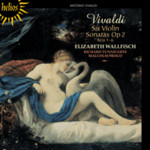
Six Violin Sonatas Op. 2
 $25.00
Special Order
$25.00
Special Order3 - 6 weeks add to cart
VIVALDI
Six Violin Sonatas Op. 2
Elizabeth Wallfisch (violin) Richard Tunnicliffe (cello) Malcolm Proud (harpsichord)
[ Hyperion Helios / CD ]
Release Date: Wednesday 1 August 2012
This item is only available to us via Special Order. We should be able to get it to you in 3 - 6 weeks from when you order it.
'This magnificent disc is complemented by an authoritative essay by Professor Michael Talbot. My only regret is that Hyperion has no plans to complete the set with a second volume. The quality of these performances beg for a prompt sequel' (Gramophone)
'Wallfisch could hardly ask for more attentively responsive support than she receives from Richard Tunnicliffe and Malcolm Proud, and she also has the inestimable advantage of a typically lucid and atmospheric Martin Compton/Julian Millard recording. Add to this an authoritative note by Vivaldi scholar Michael Talbot and Wallfisch sweeps the board in this repertoire' (International Record Review)
'The most striking feature of the violin writing is its intense lyricism and it is this that above all marks out Elizabeth Wallfisch's utterly musical and near-flawlessly executed performances … The remaining sonatas are impatiently awaited' (Goldberg Early Music Magazine)
'Elizabeth Wallfisch is absolutely faultless on this excellent CD' (Early Music Review)
If Vivaldi's career as a composer of violin concertos can be said to have come of age with the publication in 1711 of his Op 3, L'estro armonico, his set of twelve Sonate a violino e basso per il cembalo, Op 2, form a similar landmark in respect of the violin sonata.
The success of Op 2, which was unquestionably greater than that of the trio sonatas that Vivaldi had published as his Op 1 in 1705, is reflected in their subsequent history. The Amsterdam publisher Estienne Roger brought out a handsome engraved edition in 1712 which was followed closely by a pirated edition from John Walsh and John Hare in London. Broadly speaking, the Op 2 works are styled as 'chamber' sonatas on the model of the last six works in Corelli's highly influential Op 5 set (recorded on Hyperion CDD22047), the movements being largely selected from the five favoured dance-types: allemanda, corrente, sarabanda, gavotta and giga; but what lends these sonatas special distinction and sets them apart from their counterparts in the music of other composers writing in an immediately post-Corellian style is not ultimately their form but their manner of expression: long-breathed and passionate to the point of obsession.
Tracks:
Sonata in G minor Op 2 No 1 [10'27]
Preludio: Andante [3'44]
Giga: Allegro [2'05]
Sarabanda: Largo [2'20]
Corrente: Presto [2'10]
Sonata in A major Op 2 No 2 [9'14]
Preludio a capriccio - Presto [1'10]
Corrente: Allegro [1'54]
Adagio [1'00]
Giga: Allegro [2'23]
Pastorale ad libitum Nicolas Chédeville [2'38]
Sonata in D minor Op 2 No 3 [12'00]
Preludio: Andante [6'34]
Corrente: Allegro [2'01]
Adagio [1'21]
Giga: Allegro [1'59]
Sonata in F major Op 2 No 4 [11'22]
Andante [3'18]
Allemanda: Allegro [2'14]
Sarabanda: Andante [3'09]
Corrente: Presto [2'37]
Sonata in B minor Op 2 No 5 [7'03]
Preludio: Andante [3'08]
Corrente: Allegro [2'34]
Giga: Presto [1'18]
Sonata in C major Op 2 No 6 [8'25]
Preludio: Andante [4'45]
Allemanda: Presto [1'29]
Giga: Allegro [2'12]